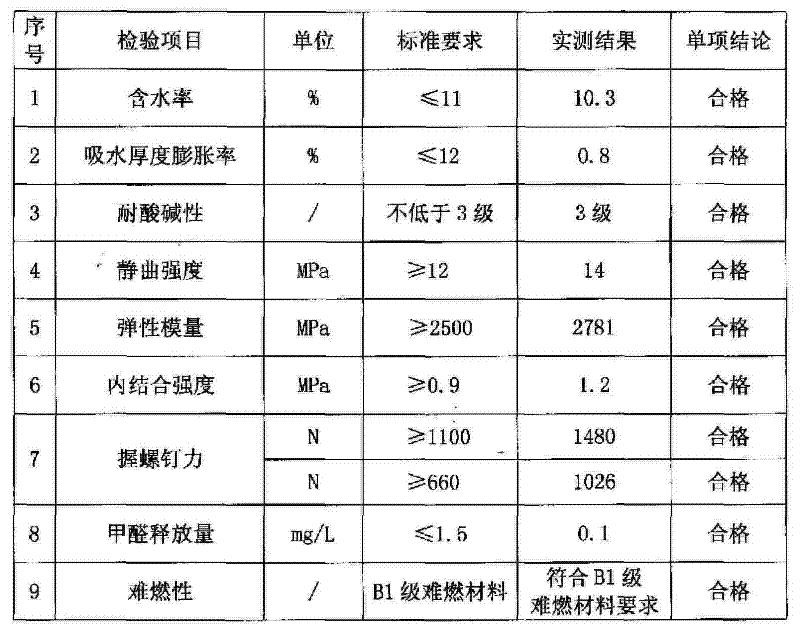Flame-retardant fiber board and manufacturing method thereof
A manufacturing method and fiber technology, which are applied in the field of flame-resistant fiber sheet and its manufacturing, can solve the problems of resource defects, brittleness, moisture return, etc., and achieve the effects of broad application fields, excellent waterproof performance, and good affinity.
- Summary
- Abstract
- Description
- Claims
- Application Information
AI Technical Summary
Problems solved by technology
Method used
Image
Examples
Embodiment 1
[0029] 1) Preparation of fibers: clean and dry 80 kg of crop cotton stalks, and then pulverize them into straw fibers through a pulverizer;
[0030] 2) Preparation of inorganic adhesive: 80kg of 80% magnesium oxide, 80kg of 25% magnesium sulfate aqueous solution, 5kg of active silicon dioxide, 0.5kg of silicone water repellent and 0.5kg of plasticizer were mixed and stirred. Inorganic adhesive;
[0031] 3) mixing and stirring the fiber and inorganic adhesive obtained in the above steps 1 and 2, and paving after screening by a screening machine;
[0032] 4) Lay 4×4 glass fiber mesh cloth on the upper and lower surfaces of the paved slab;
[0033] 5) Finally, hot-press the sheet covered with glass fiber mesh cloth for 10 minutes at a temperature of 100°C and a pressure of 12Mpa.
Embodiment 2
[0035] 1) Preparation of fibers: 100kg of wood is cleaned and dried, and then pulverized by a pulverizer to make wood wool fibers;
[0036] 2) Preparation of inorganic adhesive: 100kg of magnesium oxide with a content of 85%, 130kg of aqueous magnesium sulfate solution with a content of 26%, 10kg of active silicon dioxide, 1kg of silicone water repellent and 0.8kg of plasticizer were mixed and stirred. Inorganic adhesive;
[0037] 3) mixing and stirring the fiber and inorganic adhesive obtained in the above steps 1 and 2, and paving after screening by a screening machine;
[0038] 4) Spread 5×5 glass fiber mesh cloth on the upper and lower surfaces of the paved slab;
[0039] 5) Finally, hot-press the plate covered with glass fiber mesh cloth for 20 minutes at a temperature of 105°C and a pressure of 22Mpa.
Embodiment 3
[0041] 1) Preparation of fibers: 120kg of wood is cleaned and dried, and then pulverized by a pulverizer to make wood wool fibers;
[0042] 2) Preparation of inorganic adhesive: 120kg of magnesium oxide with a content of 90%, 200kg of magnesium sulfate aqueous solution with a content of 28%, 30kg of active silicon dioxide, 2kg of silicone water repellent and 1.5kg of plasticizer were mixed and stirred. Inorganic adhesive;
[0043] 3) mixing and stirring the fiber and inorganic adhesive obtained in the above steps 1 and 2, and paving after screening by a screening machine;
[0044] 4) Lay a 4×4 metal grid on the upper and lower surfaces of the paved slab;
[0045] 5) Finally, hot-press the plate covered with the metal grid for 25 minutes at a temperature of 110°C and a pressure of 30Mpa.
PUM
 Login to View More
Login to View More Abstract
Description
Claims
Application Information
 Login to View More
Login to View More - R&D
- Intellectual Property
- Life Sciences
- Materials
- Tech Scout
- Unparalleled Data Quality
- Higher Quality Content
- 60% Fewer Hallucinations
Browse by: Latest US Patents, China's latest patents, Technical Efficacy Thesaurus, Application Domain, Technology Topic, Popular Technical Reports.
© 2025 PatSnap. All rights reserved.Legal|Privacy policy|Modern Slavery Act Transparency Statement|Sitemap|About US| Contact US: help@patsnap.com

